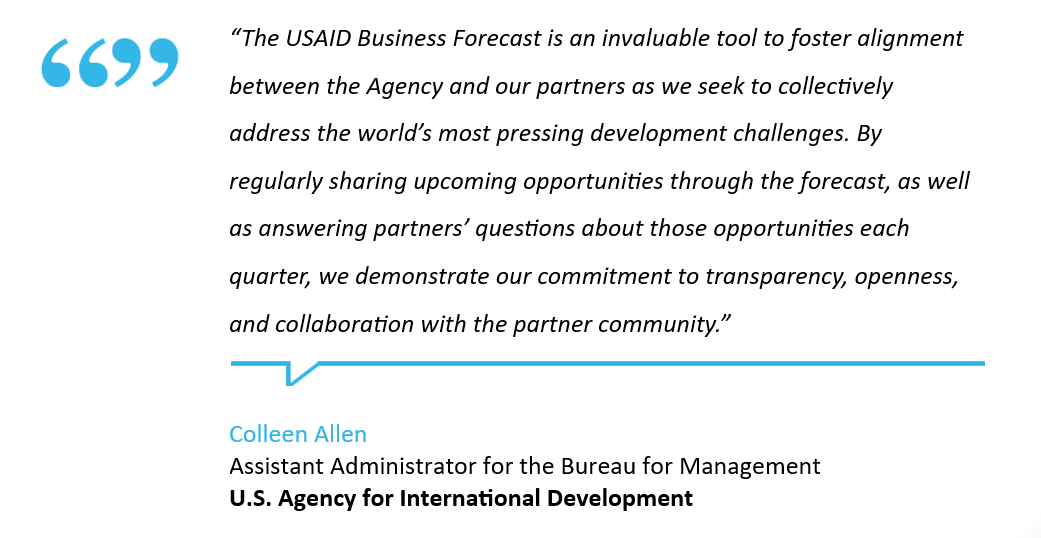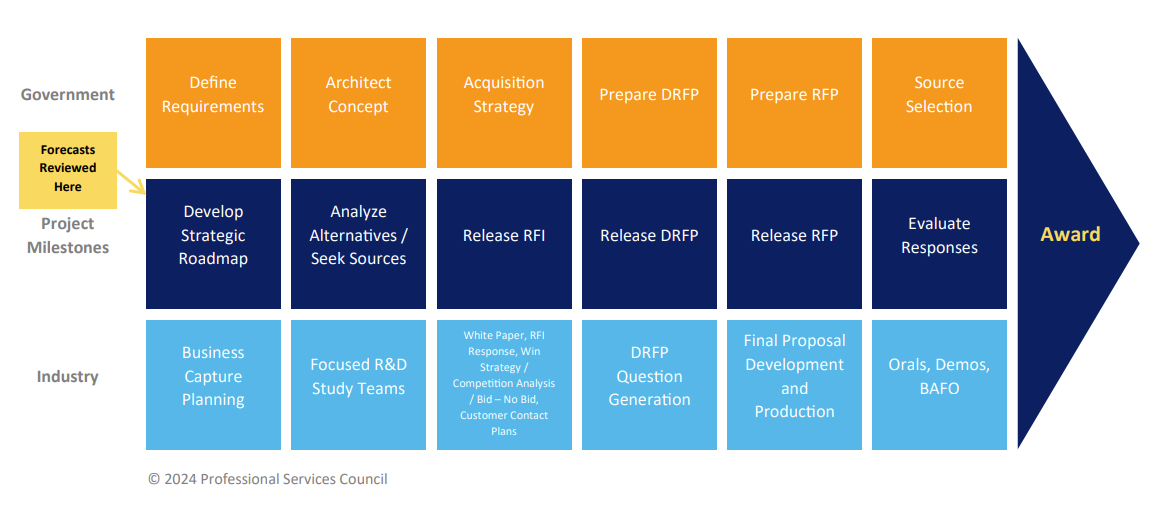
Honorable Mention: Department of Education

The U.S. Department of Education earned an honorable mention in PSC’s 2024 Scorecard for its simple yet elegant presentation of opportunity data in a single spreadsheet. This forecast is easily locatable on the website, and opportunity data are all in one place—which is preferable to multiple forecast spreadsheets with inconsistent data for different categories of opportunities. Moreover, the Department of Education’s forecast data are easily understandable: e.g., column titles are straightforward, modification dates are readily apparent. PSC found this scorecard to be an excellent example for those agencies who choose to house data on a spreadsheet instead of an integrated web interface. We encourage the Department of Education to continue providing full data in its opportunities and to add ‘date modified,’ and ‘estimated solicitation date’ fields to provide government and industry with better understanding of the timelines and timeliness of upcoming business opportunities.
Needs Improvement: National Science Foundation
The National Science Foundation’s Acquisition Forecast data is housed in a PDF. While searchable, PDFs do not enable sorting by categories and are not easily approachable. In addition, NSF’s forecast does not include many of PSC’s 15 Key Attributes for a Successful Forecast, such as contact information, expected award date, or contract vehicle type. Some of the data columns could also provide more helpful information—e.g., contract dollar values are coded by number and require scrolling to decode; expected dollar ranges could instead be written within each row. The ‘Status’ column contains an “updated quarterly” asterisk, though this provides no information as to when in the quarter the update was made, or which opportunities were changed in the update. A separate ‘date updated’ column would assist in orienting viewers to the action timeliness for each opportunity. We look forward to working with NSF on recommended improvements.
How Does Industry Use Business Forecasts?
To provide federal customers with more timely, comprehensive, and thoroughly researched solutions when final Requests for Proposals (RFPs) are released, companies rely on the accuracy, comprehensiveness, and timeliness of an agency’s business forecast, especially though not limited to the publicly available website. Often, resource allocation and teaming decisions are made well in advance of the RFP release. A useful forecast provides excellent, actionable information that can enable interested entities to determine potential staffing requirements, project needs, and costs. While PSC and the services contracting community fully recognize that spending priorities often change on short notice, significant course corrections tend to be the exceptions rather than the rule in the services sector.

Scorecard Methodology
Due to the number of agencies and subcomponents tracked, and in an effort to be as objective as possible, PSC staff take a “snapshot” of agencies’ web-based forecasts at the beginning of the second quarter of the government’s fiscal year (i.e., January). PSC staff then begin the assessment process.
- Using 15 key attributes used by services contractors who seek to make go / no-go decisions based on available information, one assessor reviews each agency’s forecast and assigns point values in accordance with those attributes. Of note, each attribute is weighted in accordance with its relative importance to industry; PSC has vetted these attributes with contractors and government officials, as well as internally within PSC.
- Other PSC staff then conduct a “blind” reassessment process wherein they are unaware of the score already assigned to an agency's forecast. This step encourages objectivity. In the event of a discrepancy between the two assessments for a particular forecast, the staff discuss their perspectives and resolve the discrepancy.
- PSC compares total scores of the assessed agencies side-by-side, determining the distribution of scores into Good, Fair, Needs Improvement, or Not Found. These cleavage points often “pop out” during the assessment process.
- Finally, it is worth noting that PSC staff arranges agencies alphabetically within each assessment category (Good, Fair, Needs Improvement, or Not Found). The listing within each category is not by score.
1. Searchable Spreadsheet
At a minimum, forecasts should be available in Excel format. Because PDFs are often difficult to read and sort, it is also difficult to extrapolate data; this complicates a potential bidder’s ability to identify opportunities. The use of a PDF may also indicate that the agency does not frequently update the forecast. PSC’s Federal Business Forecast team awards additional points for advanced Electronically Sortable Information (ESI) systems which go above and beyond Excel.
Why this matters: Excel or an ESI format allows industry to easily search for and organize opportunities and allows agencies to update forecasts more easily.
2. Date Modified
Agencies should indicate the last modification date for each opportunity. This informs users whether the information is recent or has changed since last viewing.
Why this matters: Without a date modified, contractors may be uncertain if information has changed. When uncertain, potential bidders spend additional resources on inquiries to determine relevancy and timeliness of information provided; since respondents to these inquiries are most often government officials, this also creates additional work for agencies.
3. Forecast Update Frequency
PSC’s Federal Business Forecast team evaluates forecasts on frequency of publication. Agencies should update procurement forecasts at least twice a year.
Why this matters: Potential bidders may lose confidence in the forecasting tool’s accuracy and efficacy if information appears outdated. They are less likely to expend resources for proposal preparation, possibly reducing competition for an agency’s opportunities.
4. Project Description and Contract Number
The PSC team evaluates forecasts on the existence and comprehensiveness of a project description and if the agency has assigned a contract number to the opportunity. To the greatest extent practicable, forecasts should include details on place of performance, type and scope of work, technical requirements, potential security clearance requirements, and other relevant opportunity-specific information.
Why this matters: With a more detailed description of the work required, companies can determine if an opportunity fits their capabilities, requires teaming, and is a good use of their resources to track and pursue.
5. Dollar Value (Base + Options)
The PSC team evaluates forecasts on whether the tool lists opportunity-specific dollar values, as well as the specificity of dollar values (e.g., base and option year values).
Why this matters: Potential bidders consider potential award value and structure of an opportunity to assess their own competitiveness and potential return on investment and to prioritize opportunities for tracking and pursuit.
6. Program or COR Contact Information
Agency forecasts should specify a point of contact for each opportunity—with an individual’s (not generic or office) email address and telephone number. The PSC team awards additional points if the forecast tool indicates an individual point of contact and additional “back-up” points of contact.
Why this matters: Potential bidders and the agency benefit when a specific government individual can address questions about the opportunity. Listing an email and telephone number helps make a specified point of contact more readily available, as does the inclusion of additional points of contact.
7. Program Office & Buying Activity
PSC’s Federal Business Forecast team evaluates forecasts on whether they specify program office and buying activities for each opportunity.
Why this matters: Knowing which program office and buying activity is responsible for the procurement helps potential bidder understand the government’s requirement and develop offer strategies, including but not limited to potential teaming arrangements.
8. PSC & NAICS Codes
When evaluating a forecast, the PSC team looks for specific NAICS and/or PSC code for each opportunity. Forecasts receive full points for including a NAICS code and PSC code, with partial credit awarded for having one, but not the other listed.
Why this matters: This information helps companies narrow their search for opportunities that would benefit from their capabilities.
9. New Start or Recompete with Incumbent
Does the forecast specify the incumbent for each opportunity, or does it indicate which opportunities are new / have no incumbent?
Why this matters: Knowing ahead of time that an opportunity is a new start or a recompete – and if the latter, knowing the incumbent – provides potential bidders with key insight into how best to position themselves for a successful pursuit.
10. Set Aside and Type
PSC’s Federal Business Forecast team evaluates whether the tool specifies set asides, and if so, what types (e.g., 8(a), WOSB, VOSB, etc.)
Why this matters: Including the specific set aside type allows small businesses to identify opportunities for which they may qualify and reduces the likelihood of large companies expending resources on opportunities for which they are ineligible.
11. Contract Vehicle (e.g., IDIQ, BPA)
Forecasts should indicate a particular contract vehicle for each opportunity.
Why this matters: Understanding the intended contract vehicles helps potential bidders assess the opportunity’s fit within their business model (e.g., develop prime and sub strategies) and expertise.
12. Action / Award Type
The team evaluates whether the forecast specifies each opportunity’s award type (e.g., competitive, sole source, multi-award) and contract type (e.g., fixed price, time and materials, incentive fee).
Why this matters: Knowing the award type helps potential bidders assess if their qualification and competitiveness for the structure.
13. Anticipated Solicitation Release Date
Forecasts should specify the anticipated solicitation release date for each opportunity.
Why this matters: Knowing this information helps potential bidders plan and prepare resources, including teaming arrangements that can take significant time to negotiate.
14. Anticipated Award Date
Does the forecast specify the anticipated award date and / or fiscal year and quarter?
Why this matters: Knowing this information allows potential bidders to anticipate workload and manage resources (e.g., personnel, facilities).
15. Anticipated Award Length
PSC’s Federal Business Forecast team evaluates whether the forecast includes award length.
Why this matters: Knowing the contract term / period of performance allows potential bidders to evaluate each opportunity within their existing workload and resources.